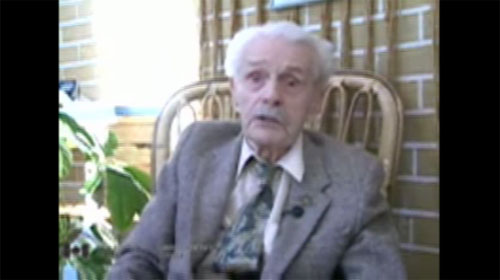Vimy Ridge
Heroes Remember
Vimy Ridge
Transcript
We were there at the taking of Vimy Ridge and that was the first
big battle the Canadians was with by their own commanders (Yes.)
and otherwise they had Colonel Byng. He was Imperial (British.)
in the British. But we had our own Commander who's name was
Currie. (Yeah.) And he was a, they say in British Columbia
he was a Real Estate Agent. He never had any military training,
but he was good. (He was eh?) He was good .
Interviewer: Was the morale good amongst the troops?
Oh yes, I'd say so. The Canadians was known, you know.
If you had any tough place to take they'd use the Canadians.
(They would eh.) We took Vimy Ridge when they said they couldn't
The French and the Imperials had tried it but it took the
Imperials. And I think the way they won that, we made festoons
of big branches (yeah) and so that the guns could
get off the road they put these festoons down, made a patch
where the guns wouldn't sink into the mud. (Oh I see, yeah.)
And that's what we did, we made these big thick,
it'd take two men to carry one. It was, it was 17, 17 feet long
I think and we'd dump them in and then they a put their guns on
this, on this platform and they could fire, enough, crawl in
short lengths (inaudible) because they were sinking in the mud.
Well we made, put these festoons, they called them.
They were bundles of branches. They'd take two men to carry.
I don't know why they were 17 feet but I just think
they were 17 feet long, and we'd dump them there, off the road.
And they got the guns down there and on this platform that we
built of sandbags and these festoons they won't sink in the
mud. So they were firing on their own fellas and they
were firing short, because the damn gun would sink in the mud it
was so thick.
Interviewer: So you with the first wave that went over the
Ridge in Vimy?
Oh yes, that was the battle of Vimy. (It must have been very
bloody). Well it was a tough, tough thing because
it was a hill, a ridge and there was two ridges.
There was one that run this way, and one this way. And now what
that one called, St. something, and this was the important one
(Yeah.) and at this end of it was high and then it gradually
lowered down to... And this was the Douai plain, up over this
ridge. And this ridge here, what was it called,
it had a name. It run (inaudible) it was like that. But I was
there billeted there, but when I woke up, I was,
I was sleeping on the gravestone, as a pillow, a grave.
At night when we landed there you couldn't see what was on the
ground, I remember that quite well.
Interviewer: And what life in the trenches like, were they,
that wouldn't have been a picnic, I suppose.
Well, you up to your ankles in mud and water.
That wasn't very nice. And a, you got use to it, but you're up
to your ankles in water, because there was a ditch just away,
away and then German's would smash the banks down and then
the water just got in all the shell holes and you were up to
your ankles in water. (Yeah).
Oh that was miserable (Yeah.) But we didn't stay long there
before was up to Lens, that was the nearest town.
But they weren't go any further, they weren't let them go any
further. Lens, because we were in a big salient, like that. And
he was hammering here and hammering there.
Well the Imperial's was defending that side. It was all mining
villages. (Oh yeah.) A row of houses. On my side we were,
there was Arras was the nearest town. Was it Arras?
(Arras Yeah) Yes, and then there was this plain,
Douai plain over the ridge was this big plain and we dug deep
trenches there for defence. When he tried each side to cut,
cut us off and take back the ridge, they couldn't do it.
(They couldn't do it eh.) They tried and tried but we just
stopped them. And on this plain we dug these deep trenches
and a when we put up such a big defence that they losing to many
men. It was costing them too much. But oh, Crocodile Trench
was the name. I don't know why I remember it.
But it was called Crocodile. It was the big trench.
It went up and the British up to the front.
Description
Mr. Chapman recalls his involvement in the famous Battle of Vimy Ridge.
Wilfred Chapman
Wilfred Chapman was born on April 25, 1898 in Peterborough, England. He came to Canada when he was about 14 years old. He moved to Toronto to live with his brother who had preceded him to this country. He enlisted in the Canadian Army when he was about 16 years old. On his arrival in England, he was assigned to a field engineers company. Mr. Chapman died in Peterborough, Ontario on October 29, 1997.
Meta Data
- Medium:
- Video
- Owner:
- Veterans Affairs Canada
- Duration:
- 05:54
- Person Interviewed:
- Wilfred Chapman
- War, Conflict or Mission:
- First World War
- Battle/Campaign:
- Battle of Vimy Ridge
- Branch:
- Army
Related Videos
- Date modified:



